In the 21st century, Church of England clergy are hard-working men and women – usually running a number of parishes, as well as struggling to pay for the upkeep of churches which may be in need of serious repair. They are expected to have several services on Sundays, possibly in different parishes, and to see to the spiritual needs – and often the material needs, if the parish is a poor one, of their parishioners. They are also pretty poorly paid. Still, at least they can count on a roof over their heads and the job carries a pension and the security of knowing that they will have somewhere to live once they retire.

Henry Tilney at Woodston, Northanger Abbey
It was not always thus. In fact, the system was so different that I was shocked at how arbitrary and unfair it used to be.
Three of Jane Austen’s heroes are clergymen, and all of her novels have clergymen in them, most of whom are important to the story. As well as the heroes, Edward Ferrars in Sense & Sensibility; Henry Tilney in Northanger Abbey; and Edmund Bertram in Mansfield Park; Pride & Prejudice also has Mr Collins, and Emma has Mr Elton.
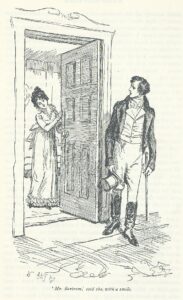
Mary Crawford tries to entice Edmund Bertram, Mansfield Park
The whole system depended on patronage. There were 11,600 benefices, that is, church livings in the UK, from a position in a cathedral, to being a clergyman living in a humble vicarage, or in a more wealthy rectory. About 2500 of the benefices were in the gift of bishops or cathedral chapters; and these obviously went to the relations and dependents of bishops, canons and so on. 600 benefices were in the gift of various Oxford or Cambridge colleges and public schools; 1,100 were in the gift of the Crown; and 5,500 benefices were in the gift of private landowners – like General Tilney and Sir Thomas Bertram, both of whom have respectable livings they are nursing for their younger sons. And readers of Pride & Prejudice will remember that Darcy’s father had intended that the good living in his gift should go to his god-son, Mr Wickham.
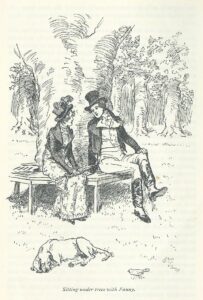
Edmund Bertram and Fanny Price, ‘Mansfield Park’
It was virtually impossible to become ordained without having been to either Oxford or Cambridge University – which, of course, meant that there was a serious class (and financial) barrier from the beginning.
Furthermore, the value of the livings varied hugely from a mere £100 p.a. to the £700 p.a. which awaited Edmund Bertram at Thornton Lacey in Mansfield Park. But the annual amount a living brought in could be greatly augmented if the benefice were a rectory, rather than a mere vicarage. The living of Hunsford, which Lady Catherine bestowed on Mr Collins in Pride and Prejudice, was a good one – possibly worth £500 p.a., and as rector, Mr Collins was entitled to a tithe, that is 10%, of all the farm produce within the parish, as well as the revenue from the glebe, the farmland which went with the parsonage itself. We know that Hunsford has at least two meadows and that the Collinses keep cows and poultry.
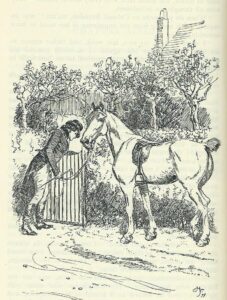
Edward Ferrars returns to Barton Cottage, Sense & Sensibility
The whole point of getting a living, however small, was that it came with a parsonage, that is, a place to live, a garden, and, one hoped, a couple of fields. It was essential that the vicarage was capable of being self-sufficient. The newly-married Elinor Dashwood and Edward Ferrars (Mrs Ferrars having given her son the promised £10,000) settled down in Delaford Parsonage, a living worth £250 p.a. and were able to grow enough to feed themselves.
Furthermore, in Jane Austen’s time, the Church of England offered no pensions to retired clergymen and there were no provisions for widows and orphans. Mrs and Miss Bates, wife and daughter of a former vicar of Highbury in Emma, have been left very badly off, and live in poor lodgings on very little money. They rely on the generosity of other, wealthier, parishioners to keep their heads above water.

Henry Tilney – the country gentleman, ‘Northanger Abbey’
Another difference which struck me was how much free time vicars had on their hands. Henry Tilney, for example, spends much of his time with his dogs and horses, and he employs a curate, (who would probably have been paid between £50-100 p.a. and whose job it would have been to take the actual services).
I had also taken for granted that church services in Jane Austen’s time would be as frequent as they are today – that is Morning Service, Holy Communion and Evening Service every Sunday; a daily early morning service, a possible service mid-week, Sunday School, and so on. Furthermore, I also assumed that the churches would be full on Sundays. Wrong. The typical early 19th century church was probably medieval and little altered since the Reformation in the 1530s. Non-attendance was commonplace, many churches were in an appalling state of repair; one vicar observing that the inside of his church had not even been whitewashed within living memory.
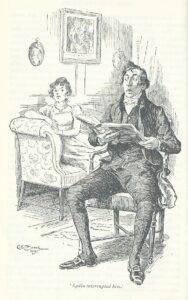
Mr Collins reads aloud from Fordyce’s Sermons, ‘Pride & Prejudice’
A vicar was expected to take a Holy Communion Service only three or four times a year. He didn’t even have to write his own sermons, there were plenty of published ones, like Fordyce’s sermons which Mr Collins chose to read out loud at Longbourn when he visited in Pride & Prejudice – and which Lydia so rudely interrupted.
Holding a regular Sunday service was the exception rather than the rule. When the young Queen Victoria talked to Lord Melbourne about the importance of regular church-going, Lord Melbourne replied that in his youth church-going was not much done, but added, ‘But it is the right thing to do.’ His private view can probably be summed up by his remark after hearing an evangelical sermon, ‘Things have come to a pretty pass when religion is allowed to invade the sphere of private life.’
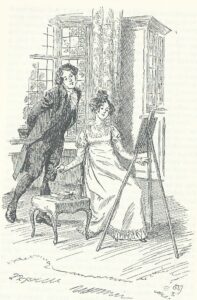
Mr Elton admires Emma’s portrait of Harriet Smith in ‘Emma’
So what did the vicar of a parish actually do? Elizabeth Bennet and Sir William and Maria Lucas visited the Collinses around Easter – today, the busiest time of the church year. Nevertheless, we hear of Mr Collins driving his father-in-law round the countryside every day during his visit, and of dinners at Rosings with Lady Catherine de Bourgh; but there is no mention of any church activities.
Mr Elton was always happy to play backgammon with Mr Woodhouse of an evening; the only engagement we hear of is him going up to London to have Emma’s picture of Harriet framed, which caused him to miss a meeting of the whist club at the Crown. Hardly what one expects of a vicar. And yet Mr Knightley himself calls Mr Elton a ‘very respectable vicar of Highbury’ – and he does visit old Mrs Bates.
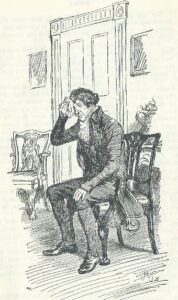
Mr Elton on a hot day, ‘Emma’
However, we must note the Monday parish meetings, which were an important part of the way the church was run. (Both Mr Elton and Henry Tilney mention Monday parish meetings.) They discussed practical problems in the parish, like repairs to the church which, if serious, could entail the churchwardens levying a rate on all parishioners depending on the value of their property. All male residents who owned land were entitled to have their say at the parish meetings which took place in the church vestry.
The Monday parish meeting was also a good place to meet your neighbours if you wanted to rise in the world. It is a place where Mr Cole, in Emma, for example, could meet other landowners and become involved in the general smooth running of Highbury. Mr Knightley is the chief magistrate, and Mr Weston and Mr Cole are his assistants, and we note that both men, having been involved in Trade, need to prove that they are now taking on the responsibilities proper to gentlemen landowners.
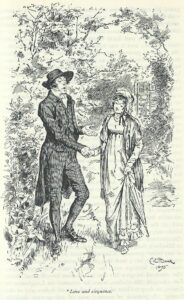
Mr Collins proposes to Charlotte Lucas, Pride & Prejudice
One gets the impression that a large part of a country vicar’s job was to provide a sort of social glue. Visiting the sick, certainly, but also giving advice to churchwardens or anyone else, and seeing that village life ran smoothly.
It was also important that a vicar get married. Lady Catherine de Bourgh was firm on that point: ‘Mr Collins, you must marry. A clergyman like you must marry – choose properly, choose a gentlewoman for my sake, and for your own, let her be an active, useful sort of person, not brought up high, but able to make a small income go a good way.’
Charlotte Lucas was the perfect choice. It is interesting that a clergyman’s wife’s status was rather more fluid than most. Mr Elton obviously feels that his status is high enough to allow him to aspire to Emma Woodhouse’s hand in marriage. Emma herself feels that the beautiful but socially dubious Harriet Smith would be a more suitable match. In the end, he goes for Augusta Hawkins, a parvenu young woman with a good dowry but vulgar manners.
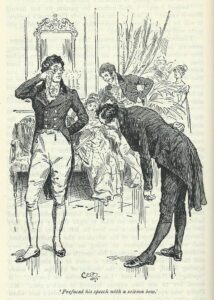
Mr Collins accosts Mr Darcy at the Netherfield Ball
Mr Collins, however, has the firm conviction that his being a clergyman has put him on the same social level as Mr Darcy, and accosts him at the Netherfield Ball – to Elizabeth Bennet’s huge embarrassment. It is made very clear that Mr Darcy thinks that Mr Collins’ intrusion is an impertinence.
I want to end by looking briefly at the case of Charles Hayter, Charles Musgrove’s first cousin in Persuasion. Charles Hayter is an eldest son, and heir to the small estate of Winthrop together with another farm with good agricultural land. Young Charles had ‘chosen to be a scholar and a gentleman’ and, somehow, (unlike his brothers) he has had a decent education and gone to university. He is now a curate.
It is a good example of how a young man, willing to work hard, and with a bit of help could rise up the ladder. If Charles won a scholarship to a decent public school, he could also have won a further scholarship to university. We are also told that, ‘Charles has a very fair chance, through the Spicers, of getting something from the Bishop in the course of a year or so . . .’ In other words, Charles has connections and friends in high places.
The snobbish Mary Musgrove looks down on the Hayters, and is very against a match between Charles Hayter and her sister-in-law, Henrietta Musgrove, considering it ‘a most improper match.’ but she is mistaken. It sounds as though Charles has his head screwed on; he could, if sponsored by a friendly bishop, do very well indeed.
Illustrations: All the illustrations are by Hugh Thomson, apart from those for Pride & Prejudice which are by Charles E. Brock, and originally drawn for Macmillan’s Illustrated Pocket Classics. The Thomson and Brock illustrations for Jane Austen’s novels have always struck me as being perfectly matched to her books.
Elizabeth Hawksley
Please share this page...
This is incredibly helpful, Elizabeth. I am bookmarking it for future reference. You have really drawn the picture so well. I knew some of it, but not all. I certainly knew that clergymen didn’t do much clergying and were very busy socialising instead! I’ve had lots of vicars and I usually do make them do at least a Sunday service, so they don’t get away with it quite so much in my books, though they do get to socialise. They are terribly useful for having impecunious daughters or nieces with whom the high-born hero can fall in love!
Thank you, Elizabeth.I’m delighted that you’ve found it useful! And you are so right about the impecunious daughters and nieces; the poor creatures only have governessing to look forward to if they don’t manage to bag a husband.A book I found really useful was Irene Collins ‘Jane Austen and the Clergy’ published in 1993 by the Hambledon Press.I seem to have spent the last few days looking up words like ‘advowson’ and what, exactly ‘small tithes’ were!
Perhaps I can add one useful fact. Why are Oxford and Cambridge colleges the patrons of benefices? Many of them actively bought advowsons – the right of presentation of clergy to benefices – so that they could place their fellows. The fellows would then have an income (out of which they paid a curate to do the actual work) and be available to the college at little or no additional cost. It was estimated a while ago that around 7% of benefices are still in the hands of Oxford and Cambridge colleges.
Thank you for your interesting contribution to my post, Graham. I came across the fact in Irene Collins’ book, ‘Jane Austen and the Clergy’ but I didn’t discuss it as it wasn’t strictly relevant to my post. The fact that 7% of benefices are still in the hands of Oxford and Cambridge colleges is, surely, shocking. I’m surprised that it hasn’t been stopped – though perhaps that’s naive of me.
Hi Elizabeth and Graham. I am a Churchwarden and the living of the church is still held by one of the Oxbridge colleges. They are consulted when a new vicar is appointed, having been chosen by the Parochial Church Council, but they really have no power any longer. In addition, I think I might dispute your suggestion that vicars currently contribute financially to the upkeep of the church buildings. Some of it comes from the collection during a service but otherwise fundraising for upkeep, Parish Share, insurance and bills is organised by the PCC, with support from the vicar. As you point out, they are not particularly well paid and there are 10 churches in our benefice.
Thank you so much for this, Alice; you bring me right up to date, for which I’m very grateful.
This is really interesting, thanks for sharing your research results.
I suggest that there must have been at least one Sunday service in every parish, though, if perhaps not much else: in Mansfield Park, Sir Thomas says of Edmund, “… he might ride over every Sunday…and go through divine service; he might be the clergyman of Thornton Lacey every seventh day for three or four hours…” which suggests at least two services on Sunday but little else. And in Portsmouth, the family goes to church every Sunday: “Mrs. Price took her weekly walk…directly after morning service…” which suggests there might also be an evening service.
And in P&P, “…and then there were merely asked on leaving church to come there in the evening.”
In Persuasion, Henrietta regrets Dr. Shirley’s sacrifice of his health “for the sake of duties, which may be just as well performed by another person.”
I’d suggest that the great majority of people did go to church once a week, and that this was not the exception but the rule. And a rather firm rule at that. It may be a question of perception—people were going less often than in the previous centuries, and they felt this as a kind of dereliction. So when Melbourne says it was “not much done” he means that chapels like the one at Sotherton had fallen into disuse, that people were not getting up at dawn every day to worship together (which Fanny regrets, but Mary applauds), he doesn’t mean they didn’t turn up every Sunday. There clearly had been a slippage during the 18th century, but only up to a point. Right through the Victorian period there is plenty of evidence in literature that everyone was expected to go to church once on Sunday, if not more often.
People were judged if they did not go to Sunday service, there was something dodgy about such a person. And every church must have had a Sunday service in this period. Our own laxity on the subject confuses us when we try to understand the past in this area, but even as recently as sixty years ago it was shocking—or at least noted— if someone failed to attend Sunday morning service in a village. In the cities things were by then easier in some respects—but not if you lived in a strong community within the city.
Thank you, Alexandra for your thoughtful response. I stand by my original assessment, however, and I urge you to read Irene Collins’ excellent ‘Jane Austen and the Clergy’ on the subject. I think that church-going fell to its lowest level during late 18th – early 19th centuries and it was probably the rise of Nonconformism – Methodism especially, which pushed the Anglican church into action. This, in turn, was followed by the Oxford Movement in the 1830-40s.
If church-going was the norm, where is the vicar of Meryton? Who was it who married Mr Collins to Charlotte Lucas? Or Mr Darcy to Elizabeth Bennet, or Mr Bingley to Jane Bennet, for that matter? We do not know. He is never mentioned.
Some men, like Edmund Bertram, obviously feels drawn to the church and can see himself being useful as a vicar; others like Henry Tilney, don’t seem that interested. He’s happy to do the looking after the parish bit, riding over the countryside with his dogs, but he leaves the church services to his curate. Catherine doesn’t seem concerned whether he is in Holy Orders or not. It is interesting that Hugh Thomson’s late 19th century illustrations for Jane Austen’s novels show Henry Tilney, Edmund Bertram, and Edward Ferrars wearing the usual country gentlemen’s clothes – not in something specifically clerical like Mr Elton’s garb. And I’ve always found his illustrations spot on costume-wise.
In my opinion, the great revival in church going, together with a rise in moral earnestness, was a Victorian phenomenon – and it was Victorian novelists: Trollope, Mrs Oliphant, George Eliot and Charlotte Mary Yonge, especially, who recorded the religious passions which swayed their characters’ lives. Dickens, too, has a lot of fun with characters like Mr Chadband in ‘Bleak House’.
Well, I’m going to stick to my guns, too. It’s an interesting question.
In five of Jane Austen’s six complete novels (all except Persuasion), a clergyman plays either the male lead or a large supporting role. I suggest that that is evidence of how important the occupation was. Some of them are vicars of very small villages—Thornton Lacey is so small it has no squire’s house to compete in prestige with the vicarage, but still it has a church and regular Sunday services. Mansfield seems little larger, but the vicars there are very visible in the story, and certainly preach every Sunday. Edward Ferrars, too, ends up as vicar in a small village. He certainly would have held services every Sunday, don’t you think? Woodston, where Henry Tilney is vicar, is “large and populous”, but still a village, not a town. It seems unlikely there would have been vicars and regular service in such small locales but not in larger centres, and anyway, we know London was full of priests, and that they had to have a special style of delivery to appeal to more demanding London congregations. And even sophisticated, blase Henry Crawford attends church when in London, or he would not be able to discuss those speaking styles with Edmund.
Lack of evidence for the existence of a thing is not the same as evidence for the lack of existence of that thing. Sometimes the very fact that a thing isn’t mentioned is evidence for how common it was—nobody remarks on it because everyone assumes it. In modern novels, just to take an example at random, how many do not actively mention public transport? How often does Austen mention shopkeepers? Only, I think, in Emma does one actually get to speak, and yet we know they were there. So the fact that the vicar of Meryton isn’t personally mentioned doesn’t seem to me to be evidence of anything. Perhaps it was a parish that had been given over to a curate. Curates, as you note in your original post, were paid a pittance, and that alone would have prevented them from socializing with the Meryton family. Notice that Mr. Collins and Charlotte do not socialize with their neighbours, either, because they can’t afford it. In a story about upper class people in Hunsford, would Mr. Collins figure, even if he did marry the principals in the end?
The question you ask—who married them?—actually tends to support my position more than yours: if there was not a vicar in Meryton, who married everybody? Who buried them, too? If they had to go to a larger centre to find a vicar, that is more likely to need a mention than if they simply went to their local church. I think it’s an assumption her readers would have made, because every village had one. If only one village in a group of several actually had a vicar and people had to travel to get to church, that would surely occasion a mention in at least one of the books, e.g. a mention in the discussion of the living someone is given, that the church served five of the surrounding villages. Something like that I would expect.
I also think reference to the morals of the time is relevant in this regard: Maria Bertram is ostracized for her “dreadful crime”. It would have been an insult to the neighbourhood for Sir Thomas to countenance what she has done by allowing her home and expecting the neighbourhood to notice her. This is surely morality based on religion—if not, on what? Maria is sent to some remote place where the news of her actions will follow her, and the neighbours will shun her, so that she is shut up “with little society” except Mrs. Norris. Henry, meanwhile, gets off scot free. To me, that is clearly a religious thing—it is women who carry the burden of religious purity, then and now. England’s morality was based on Christianity, nothing else. Christian missionaries fainted when they discovered some of the sexual practices of native populations. It was the main thing they tried to change in ‘pagan’ societies. In Persuasion (I think), Anne disapproves of the fact that William Eliot was used to travelling on Sunday.
In London, things are treated differently, that much is clear. But it doesn’t suggest to me that people didn’t attend church, nor that there was any deficiency of churches. It just meant they wanted a more entertaining sermon delivery.
As for the vicar’s costume, Mary Crawford explains it: “Luckily, there is no distinction of dress nowadays”. I don’t know when that happened, but as there are only a few years between P&P, Emma and Mansfield Park, it suggests that if Mr. Elton does wear his religious gear in ordinary life, he does it for a reason—and that reason isn’t far to seek: he thinks it gives him status. (Or perhaps so that he doesn’t have to buy mufti.) Similarly with Mr. Collins, who is often shown in clerical gear. If they think it gives them status there must be *some* basis for the conviction, don’t you think? But I don’t remember anything in either book that mentions their dress, and if there isn’t any such mention, might it be that artists choose to put them in such costume for their own reasons? None of the three heroes you name is presented to us in his strictly clerical capacity, as both Elton and Collins are…they begin and end as clergymen. Edward and Edmund and Henry Tilney all are introduced in a different function—their profession is not their central function.
It is also very clear that it is partly Mary’s disdain for the clergy that makes Fanny distrust her so deeply, and marks her as having a “tainted” mind, and that Jane Austen expected that distrust to be shared by her readers. And part of this, too, must be the distrust of London, where morals were clearly much shadier and its influence considered a negative by those who did not live there.
And of course the Victorian era was much more prudish and priggish and judgemental—in fact, I see Fanny and Edmund as being a kind of harbinger of the Victorian era. I’ve often thought that by the time they get to their fifties they’ll be unbearable prigs. But the root is already there—the Victorians didn’t come from nowhere.
Even if church attendance fell in those years (although as you point out, the rise of Methodism may have meant the figures are distorted as only the CofE attendance was counted), I don’t think that suggests at all that churches were closed or had no services. The CofE got anxious about dissenters and maybe there was a lot of fuss created so as to get grants for the building of new churches?
But I’ll look out for a copy of that book.
Thank you for your interesting comments, Alexandra. Plenty of food for thought there. And I think your point about Fanny and Edmund being ‘a kind of harbinger of the Victorian era’ is spot on!
Elizabeth, thank you for your fascinating and informative post. And so timely, as my 2nd book (about to start writing) in a new series will feature a parson and his wife (secondary characters) and sister-in-law (heroine). There is so much information in your post that will be very useful. In fact it has changed my perception of how to get my heroine to join her sister.
Thank you again. 🙂
Brilliant, Sherry. I’m delighted to have been able to help. I see we’re both part of the RNA Facebook Historical romance chapter – please feel free to get in touch, if I can help.
How fascinating! It is precisely because of articles like this one, that I continue to enjoy reading this blog every week.
This is a subject I had, until now, had no interest in or even thought about, and yet I found your article interesting and thought provoking.
I wonder if there were any clergy that had fought in any wars? I know that in the Orient, the warrior monk tradition was very common.
What an interesting question, Huon. I don’t know the answer. I don’t think the UK has a tradition of warrior monks, unless the Knights Templar during the crusades count in the 11th-13th centuries. I’m sure that all regiments had their padres but they weren’t expected to fight.
Fascinating. Recently I’ve been catching up on Anthony Trollope, his books written much later, in the mid I8OOs, of course. It’s interesting how the young Rev Mark Robarts, having been given the living by Lady Lufton, employed a curate to take many of the services. But his wife warned that Lady Lufton would be annoyed if he missed too many Sundays because he was away visiting dubious friends! So the system continued.
Thank you for your intelligent observation, Susie. Nothing changes overnight; I expect there were Mark Robartses seeing what they could get away with throughout the 19th century and possibly into the 20th century, certainly before the First World War. And, of course, Lady Luftons believing that they had the right to interfere!